The Centre Pompidou, a central fixture in the Parisian art scene, closed its doors on September 22 for a five-year major renovation. In a spectacular farewell, the museum, alongside mega-gallery White Cube, put on “The Last Carnival,” a monumental daytime fireworks display by renowned Chinese artist Cai Guo-Qiang.
Set against the vibrant backdrop of Art Basel Paris—the zenith of the Parisian art season—the display of colored gunpowder unfolded in three explosive acts: The Banquet, The Dawn of AI, and The Last Carnival. Conceived using Guo-Qiang’s custom AI model, cAI™, the fleeting fresco represented the Pompidou’s gaze toward the future.
“For the first time in its history, the Centre Pompidou’s façade becomes a monumental painting,” curator Jérôme Neutres said. “Cai delivers his most profound and complex work yet, in dialogue with both AI and the Parisian public.”
Born in Quanzhou, China, in December 1957, Guo-Qiang’s work covers the swath of creative mediums, from painting, installation, video art, and performance art. Most recently, he has become renowned for his mastery of the firework. But the artist’s work has often been the subject of controversy.
His most recent show at the base of the Himalayas in Tibet led to stinging criticism online and his 2024 performance as part of the Getty-affiliated Pacific Standard Time initiative faced reports of injuries and falling debris. As reported in the Los Angeles Times, “residents in the surrounding South L.A. neighborhood said they thought bombs were exploding, and the smoke that wafted into their streets unsettled them, forcing some to close windows and leading others to believe that they were in the midst of an emergency.”
